 I am not going to go again into honey beers I like – by now I imagine you have identified the trend here!
I am not going to go again into honey beers I like – by now I imagine you have identified the trend here! All about Belgian Beers. Belgian Beer Bars. Belgian Beer Breweries. A discovery of the many Belgian Beers. In a nutshell Belgium and Belgian Beers. www.belgian-beers.eu Cheers!
Thursday, December 15, 2005
Belgian Beer no.12: Biere des Ours, the bear beer
 I am not going to go again into honey beers I like – by now I imagine you have identified the trend here!
I am not going to go again into honey beers I like – by now I imagine you have identified the trend here! Belgian Beer no.11: Saint Monon, honey!
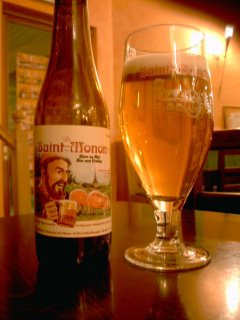 Probably not the first time I mention I like honey beer. Therefore my quest to discover them all one by one. This is how I came across a honey beer I never heard of, the Saint Monon miel.
Probably not the first time I mention I like honey beer. Therefore my quest to discover them all one by one. This is how I came across a honey beer I never heard of, the Saint Monon miel.Brewed at the Saint Monon Brewery, this beer has again a very high alcohol content (8%) – and for my taste not too much honey flavor. I will get to the stage where I am going to just add honey to a blonde … sin, sin, sin.
To get back to the Saint Monon though, I liked it. A nice, clear beer which I enjoyed and will most likely buy again.
Carrot soup with cumin (serves 4)
600gr carrots
1 onion
2 tsp cumin seeds
I knob of butter, 1 drop olive oil
50cl Saint Monon (or any other strong honey beer)
25cl water
1l stock
Salt and pepper
Goats cheese
Heat the butter and olive oil in a pan, add the onion and cumin seeds. Add a little honey beer and let it simmer, till caramelized. Add water and stock, honey beer (save 1dl), the finely chopped carrots. Let the mixture cook on low heat for 5-8min.
Blend the soup, add the remaining beer, salt and pepper (if necessary).
Serve hot with a slice of goats cheese on top of the soup and full grain bread.
Tuesday, December 13, 2005
Belgian Beer no.10: Pater Lieven, available as 4
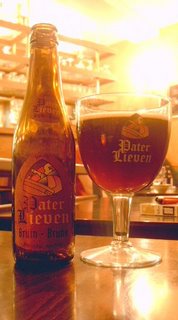 Pater Lieven, brewed by the Van den Bossche brewery in the Flemish Ardennes, is available as light (blond), dark (brown), triple and as a Christmas beer. We gave the Pater Lieven bruin a try.
Pater Lieven, brewed by the Van den Bossche brewery in the Flemish Ardennes, is available as light (blond), dark (brown), triple and as a Christmas beer. We gave the Pater Lieven bruin a try.At 6,5° this is again a very strong Belgian beer, with hints of caramel, chocolate and pils. A very dark beer, Pater Lieven is ‘only’ been brewed since 1957. The brewery itself is over 100 years old, but it seems this particular beer has only been discovered and marketed later. However, it stands today as a very much sought after Belgian beer.
Belgian Beer no.9: Tripel Karmeliet, all the way from 1679
 With Christmas near and winter officially here, Belgian beer drinking is again on top of our evening agendas. Depending on location, we either go for the deeper, darker richer beers, or for the mulled wine. Beer while visiting and discovering Beermania, mulled wine while visiting the Christmas market in Brussels.
With Christmas near and winter officially here, Belgian beer drinking is again on top of our evening agendas. Depending on location, we either go for the deeper, darker richer beers, or for the mulled wine. Beer while visiting and discovering Beermania, mulled wine while visiting the Christmas market in Brussels.One evening, four different beers. I was looking for my usual sweet, ideally honey flavored beers, while competing with a more unusual search for different beers. So we started off with a Tripel Karmeliet. Now this is a beer I liked. Although I usually go for sweet to very sweet beers, I found this beer had that extra special flavor and taste – and yes, I liked it!
Still brewed after an authentic recipe from 1679, this beer brings together three different types of grain: wheat, oats and barley. What I found probably to be a caramel taste, were the aromas of vanilla the beer has. But to be perfectly honest I was most impressed by the very stylish glass the beer is served in.
Duck with baby onions (serves 4)
duck breast
1 orange
2 finely chopped shallots
2.5dl Tripel Karmeliet
2dl chicken stock
1 tsp honey
2 cloves garlic
2 tsp red wine vinegar
Fry the duck breasts for aprox 10min. At the end add the shallots and the garlic. Remove the meat from the pan and keep it warm. Mix the juices with the red wine vinegar, Tripel Karmeliet, honey, chicken stock and a piece of the orange peel. Allow this to reduce and serve on top of the duck breasts.
Tuesday, October 25, 2005
Belgian Beer no.8: La Hervoise, a new discovery
 There is some confusion over this beer. If I would have to go by the label, then the beer is brewed at the Brasserie Grain d'Orge. However on their website there is no sign of the beer.
There is some confusion over this beer. If I would have to go by the label, then the beer is brewed at the Brasserie Grain d'Orge. However on their website there is no sign of the beer.If the information the Internet offers is accurate and should be taken into account, then the Hervoise is brewed at the Brasserie Vervifontaine, a small brewery next to Liege in Jalhay.
Until this mystery is solved (I think best will be to e-mail the Grain d’Orge experts and see what they advise on the above-named beer), some information on the beer: it is a strong ale like beer, slighty sparkling, brewed using the syrup de Herve which gives it a slight apple and pear taste.
A classic beer paired in the region with the plateau de Herve cheese, it was indeed a beer that pleasantly surprised us. You will ask, what about the glass, the recipe? The glass exists. However difficult to find in Brussels, it will have to be bought when visiting the brewery where this beer comes from. As for the recipe, I’ll have to pass this beer as I didn’t find anything specific to this beer. I guess a Hervoise with a plateau de Herve?
Monday, October 24, 2005
Belgian Beer no.7: Mort Subite, the trendy line
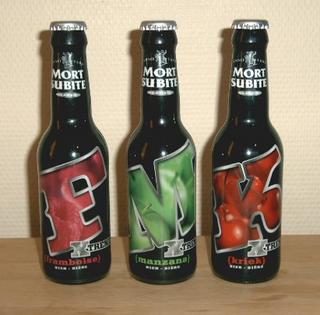 Now aren’t these the most funky looking beer bottles you have seen? I bought them solely for their looks. I think they almost look ready to hit the clubs and become the new ‘en vogue’ drink.
Now aren’t these the most funky looking beer bottles you have seen? I bought them solely for their looks. I think they almost look ready to hit the clubs and become the new ‘en vogue’ drink.Mort Subite geuze beer is nowadays produced by the Alken-Maes brewery. However the beer is placed as far back as the 17th century, when it was produced in De Keersmaeker brewery.
The name of of Mort Subite, or Sudden Death dates back to the 20th century. A Brussels pub, known as La Cour Royale was known for its entertaining atmosphere. Throwing the dice was a popular game, and the loser of the game was called out ‘morte – dead’. If the game had to be suddenly stopped, because duty called, the players threw a final hand, the ‘morte subite’, or ‘sudden death’. And given the beer drank by the players was a particular gauze, the beer was later named after the game, ‘Mort Subite’.
There are 5 classic Mort Subite types of beer, with a 6th one recently added. There are the Mort Subite Geuze, Kriek (cherry, on the right), Framboise (raspberry, on the left), Cassis (blackberry), and Peche (peach). The latest addition is Manzena, based on apples (in the middle). Besides adding a new flavor, a new look, an Xtreme look, was also created for the Mort Subite beers. Additionally, let me tell you these beers are also Xtremely sweet.
1000g beef carbonnade (beef cut into cubes)
100cl Mort Subite Gueze
6 onions
15g flour
50gr butter
2 slices white bread
2 spoons brown sugar
1cl vinegar
2 spoons mustard
s&p, thyme, sage, parsley
Cut onions in rings. Melt butter in a pan, brown the meat, then set the meat aside. Add onions to the fat and brown them while adding the flour.
Add the gueze and bring the mixture to boil.
Add the meat, and the herbs, sugar and vinegar, s&p.
Spread the bread with mustard and add it to the sauce. Simmer the whole for 1 1/2h.
Serve with fries or boiled potatoes.
Belgian Beer no.6: Duvel, the devil beer
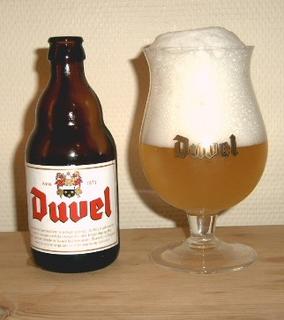 Duvel means ‘the devil’ in Flemish. And a devilish beer it is. Served in a tulip like glass (yet again a unique glass for this beer only), it is 8,5% alcohol and trust me, you can feel that.
Duvel means ‘the devil’ in Flemish. And a devilish beer it is. Served in a tulip like glass (yet again a unique glass for this beer only), it is 8,5% alcohol and trust me, you can feel that.Brewed by Duvel Moortgat since the late 1800, Duvel is one of the most popular beers of Belgium. Brewed for the first time just after the First World War, Duvel was known at first as ‘Victory Ale’. Following though its devilish nature, it soon became ‘Duvel’. And has been known under that name ever since.
The classic ‘red’ Duvel is the one usually available for mass consumption, however a less strong version exists as well, the ‘green’ Duvel. Today sold all over the world, Duvel has become a reference point for Belgian beer and I doubt you will ever enter a Belgian bar without seeing someone with a Duvel in front. Probably a Duvel without the foam 'hat' as I poured it, but a Duvel nevertheless.
Marinated pork fillets in Duvel (serves 4)
2 pork fillets
2 spoons mustard seed
1 bottle of Duvel
50 gr of butter
flour
s&p, little sugar, parsley
Cover the fillets generously with mustard. Place them in a dish, pour the beer over them and cover with a foil in order to keep them fresh. Marinate them overnight in the fridge.
Next day remove the mustard from the fillets, rinse and dry them. Then roll the fillets in flour and fry them in half of the butter. Season with some salt and sugar.
Pour the marinade of mustard over the meat, then cover the dish and leave it simmer for about 10 minutes.
Remove the fillets from the sauce, and set them aside (keep them warm). Thicken the sauce by mixing in the remaining butter and flour. Then add the chopped parsley.
Serve with apple-sauce and potato croquettes.
Wednesday, October 19, 2005
Belgian Beer no.5: Tongerlo, an abbey beer
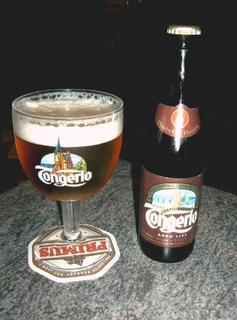 As always, Wednesday afternoon was spent in Place Chatelaine shopping, and having a drink. To my great joy, friends agreed to try new beers out so as to help me progress with my Belgian Beer page. Since starting the Blog, I co-opted friends to help me write it, and on more occasions than one to act as ‘experimental subjects’. No complaints so far.
As always, Wednesday afternoon was spent in Place Chatelaine shopping, and having a drink. To my great joy, friends agreed to try new beers out so as to help me progress with my Belgian Beer page. Since starting the Blog, I co-opted friends to help me write it, and on more occasions than one to act as ‘experimental subjects’. No complaints so far.This is how the Tongerlo beer made it to these pages. The beer is brewed in the Tongerlo abbey by the Norbertines of Tongerlo, Tongerlo Abbey is one of the most beautiful abbeys in Belgium, well worth a visit. And a gastronomic discovery, as the monks sell farm bread, butter, cheese, biscuits baked according to time-honoured traditions and of course the Tongerlo abbey beers.
Four Tongerlo beers are brewed there, the double brown and double blond, the triple blond and the Tongerlo Christmas, which as the name says it is only available during the holiday season. And of course, as it is always the case with Belgian beers, these beers come as well with their own Tongerlo glass.
Quiche with Tongerlo (serves 4)
pastry:
400g flour
30g butter
10g salt
1 Tongerlo triple blond
4 leeks
40g butter
100g bacon
1/4l cream
8 eggs
some Tongerlo triple blond
nutmeg, s&p
Mix the ingredients for the pastry with ½ of the beer, and leave the mixture in the fridge overnight.
Next day, cut the 4 leeks in fine rings and lightly fry them in the butter. Pour over some Tongerlo, and add the bacon strips (or cubes) to the mixture.
Preheat oven to 180°.
Boil the cream and 1/4l of Tongerlo.
Mix 5 egg yolks and 3 egg whites with salt, a lot of pepper, and the nutmeg.
Pour the cream mixture and the egg mixture together in one bowl.
Spread the pastry out on a round ovenproof dish.
Put the leek and bacon mixture on first, then pour over the egg and cream mixture.
In the oven for 20min or till golden.
Ideally served with a fresh salad on the side.
Belgian Beer no.4: Chimay, the first of the six chosen ones
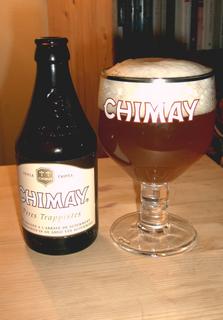 In the spirit of the Blog, and to advance on the Belgian Beer page, my last ‘investment’ was: three Chimay beers (the Red, the Blue and the Triple) and the Chimay glass.
In the spirit of the Blog, and to advance on the Belgian Beer page, my last ‘investment’ was: three Chimay beers (the Red, the Blue and the Triple) and the Chimay glass.One of the six trappist beers, Chimay products have been produced since the 1860’s. Chimay gives its name to three beers, and four cheeses: the old Chimay, the Chimay grand classic, the Chimay with beer and Chimay grand cru. I have to confess I haven’t tried any yet (how could I have missed them?) but I will soon and they will all feature on Food and Wine.
I am not an expert on the differences in beers, the tastes, so I’ll leave all the in depth information to the Chimay website. In the picture taken you can see a Chimay Triple which I know out of the three should be drunk cooler than the others (Chimay Red and Blue ideally at 10-12°, Chimay Tripple at 6-8°).
And to continue the very Belgian tradition of cooking with beer, to day a Chimay recipe.
Trout fillets in Chimay (serves 4)
8 trout fillets
66cl Chimay Blue
8 slices of Chimay classic cheese
1 spoon honey
2 spoons cream
Place the trout fillets in a buttered dish, heat the fillets briefly in the oven, remove the dish, lay a slice of cheese on each fillet, add the beer and return to the oven for 10 minutes.
Remove the dish from the oven and remove the fillets.
Lay them on a very hot plate, allow the liquid to reduce, add the fresh cream and the spoonful of honey.
Tuesday, October 18, 2005
Belgian Beer no.3: Kwak, and the interesting glass
 Imagine drinking 1 meter of beer. Never heard of something like this? Then a visit to Belgium (or Germany) is in order. Other countries might serve beer by the meter as well, but I know for sure Belgium is no stranger to the meter beer.
Imagine drinking 1 meter of beer. Never heard of something like this? Then a visit to Belgium (or Germany) is in order. Other countries might serve beer by the meter as well, but I know for sure Belgium is no stranger to the meter beer.Being on the Grote Markt in Brugge, and in line with all the tourists who were having the same, we ordered a 1m Kwak. I have to admit the experience was a first for me. I knew the beer from before, but never saw it super-sized.
Kwak has a deep bright amber color, a fruity and malty aroma, a slightly spicy character with hints of caramelized bananas, and a pleasant bitterness to it. However, what I find fascinating about the Kwak, is the glass it comes with.
History places Paul Kwak as a brewer and bar owner in Dendermonde. A regular stop for mail coaches, coachmen were not allowed to leave the carriage and horses. Therefore not able to enjoy the Kwak beer. As a result, Paul Kwak invented a glass which could be easily hung on the coach and ordered the shape of the glass we know today. Problem solved.
Lamb Ragout with Kwak (serves 4)
1 leg of lamb (1 kg)
half a green cabbage
4 carrots
4 turnips
half a celeriac
1 onion
250gr mushrooms
potatoes
1 bottle Kwak
butter, clove of garlic, tyme, bay, s&p
A golden rule - above all sweat the onion in the butter and add the vegetables in the following order: carrots, green cabbage, celeriac, turnips, potatoes. Allow to braise moistening with the Kwak beer.
Add the thyme, bay and sliced garlic. Cover and allow to cook for 20min at low heat.
In the meantime brown the meat in butter, seasoning it with s&p.
Add meat to vegetable mélange.
Put the pan in the oven at 200C (gas mark 6) and let it cook uncovered for 20min. if you like the meat well done, leave it in the oven a little longer. If rare, then take it out sooner.
Serve with a Kwak.
Belgian Beer no.2: Floris, the honey beer
 I have already mentioned the honey beers. While in college a good friend of mine took me to a small beer bar, hidden somewhere behind the little streets of Brussels. Needles to say the small beer bar served over 200 types of beers.
I have already mentioned the honey beers. While in college a good friend of mine took me to a small beer bar, hidden somewhere behind the little streets of Brussels. Needles to say the small beer bar served over 200 types of beers.Knowing I am not a beer drinker per se, I was offered to try a ‘biere au miel’ – honey beer. Again not knowing which one I should chose, when the bartender asked me which beer I’d like I promptly replied ‘a honey beer, and the sweetest you have’.
After trying to convince me the beer is really sweet and doesn’t even taste like beer, and confused looks I still want it – I tried my first ever honey beer, Floris Miel. Ever since it is my all time favorite beer (not so sure the beer world agrees with me) and I love it.
I think if like me you like sweet beers, then the Floris range is the answer. Except Floris Chocolate which really didn’t taste that great. But the rest, a very nice alternative to bitter beers. And worth a try.
Belgian Beer no.1: Kriek, the cherry beer
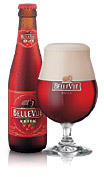 The first beer which will make its debut on this blog, is also the very first beer I tried in Belgium : the Kriek. A ruby red colored beer it is made out of cherries, slightly bitter but still very sweet. Very much a ‘girly’ beer, which has a variation on raspberry as well.
The first beer which will make its debut on this blog, is also the very first beer I tried in Belgium : the Kriek. A ruby red colored beer it is made out of cherries, slightly bitter but still very sweet. Very much a ‘girly’ beer, which has a variation on raspberry as well. 1 rabbit, cut into pieces
2 bottles of Kriek
1 jar of cherries in juice
1 knob of butter
2 red onions
maizena, honey, thym, bay, s&p
Fry the rabbit with a little butter in a casserole.
Add the finely chopped onions, the thyme, bay. Stir and let it cook.
Add to this mixture the cherries and the Kriek so that the rabbit is covered. Place in the pre heated oven for 45min.
When the meat is cooked, the sauce is let to thicken over low heat and if necessary, maizena can be added for texture.
Serve the rabbit with the sauce, roasted vegetables, potatoes or croquettes and a Kriek.
Monday, October 17, 2005
450 reasons for envy
I have to confess: I am not a beer drinker, but a devoted wine drinker. I drink beer, however the type that is dismissed by the ‘real’ beer drinkers, namely the fruit beer and the honey beer. The latter is also slowly becoming my favorite.
But a blog on Brussels and food and wine, would not be complete without a page dedicated to Belgian beer. With wine and cheese I try to taste a different one at least every week (ok, usually one or the other more than once a week). I can not promise to have the same approach to beer, but luckily for the ... blog, I have dedicated beer drinkers around me. And they promised to help, to take pictures, to write reviews. To blog.
To give you an idea of the task ahead with regards to Belgian beers (and the reason for the envy), I think a short overview would help. There are over 450 beer varieties in Belgium. The classification of Belgian beers covers normal pils beers, abbey and trappist beers, gueuze and kriek, white and brown beers, as well as seasonal beers. The trappist are beers specific to Belgium, as the only existent six Trappistes are all produced here: Achel, Chimay, Orval, Rochefort, Westmalle and Westvleteren.
And besides remembering all this information, one also has to make sure that each beer is drunk out of the right glass. Because almost every beer has a specially designed glass to accompany it.
So let the journey into the beer paradise begin.